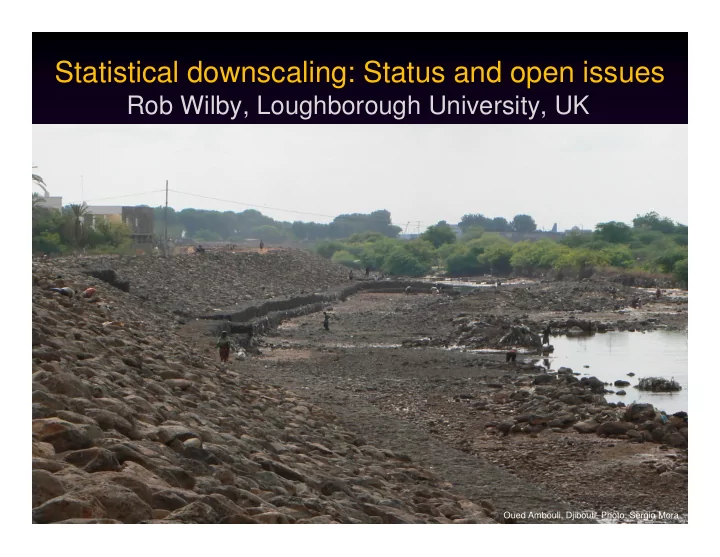

Statistical downscaling: Status and open issues Rob Wilby, Loughborough University, UK Oued Ambouli, Djibouti. Photo: Sergio Mora
Raison d’être Flooding of Djibouti by the Oued Ambouli in April 1994
The downscaling mantra What the climate model 300km centres provide… km 50km 10km 1m …what ( we think ) the climate impacts community needs. Point
Downscaling is at the heart of the uncertainty cascade ������� ������� ��������� ������� ������� ������� ����� �������� �������� ������ ����� ������
What have we learnt so far? • GCM boundary conditions are the main source of uncertainty affecting all downscaling methods • Statistical and dynamical downscaling have similar skill • Different downscaling methods yield different scenarios • There are no universally “optimum” predictor(s)/domains • Downscaling extreme events is highly problematic (for example summer rainfall predictability is very low) • Traditional skill measures for current climate may not be the best guide to future scenarios of change
“Pulse check” for the downscaling industry... "downscaling and climate" "statistical downscaling" "dynamical downscaling" "downscaling and impact" "downscaling and adapt*" 120 ublications 100 80 60 60 Journal pu 40 20 0 1993 1995 1997 1999 2001 2003 2005 2007 Year Number of ISBN research publications listed on the Web of Science. Accessed 10 February 2009
A few practical considerations Photo: Bull (1930)
Decaying observing networks The global network of the World Weather Watch (WWW) stations colour coded to indicate silence (red dot) or reporting rates in 2008. Source: WMO (2009)
Concerns about data quality in vulnerable regions 200 180 160 140 Frequency 120 100 80 Fr 60 40 20 0 0 10 20 30 40 50 60 70 80 90 100 Daily rainfall total (mm) Distribution of daily precipitation amounts recorded at Ibb (including 14.6 and 15.8 mm on 30 and 31 February 1995!)
Djibouti’s met station
“Shed-loads” of uncertainty Djibouti annual PRCP2050s Djibouti annual TMAX 2050s 60 3.5 50 3.0 40 2.5 30 e (degC) ge (%) 20 2.0 2.0 Change ( Change (d 10 10 1.5 0 -10 1.0 -20 0.5 -30 -40 0.0 CGCM3 CNRM CSIRO GFDL GISS IPSL MPI CGCM3 CNRM CSIRO GFDL GISS IPSL MPI Data source: Climate Systems Analysis Group, University of Cape Town
Tool/source Description Too clim.pact R functions for downscaling monthly and daily mean climate scenarios http://cran.r-project.org/src/contrib/Descriptions/clim.pact.html many CRiSTAL Community-based Risk Screening – Adaptation and Livelihoods http://www.iisd.org/pdf/2008/cristal_manual.pdf CSAG Data portal for downscaled African precipitation scenarios for the 2080s tools? http://data.csag.uct.ac.za/ ENSEMBLES Experimental portal for downscaling tools applied to Europe http://grupos.unican.es/ai/meteo/ensembles/index.html FINESSI Multi-sector/ multi-variable climate change scenarios for Finland http://www.finessi.info/finessi/?page=explore LARS-WG Tool for producing time series of a suite of climate variables at single sites http://www.rothamsted.bbsrc.ac.uk/mas-models/larswg.php LCA Linking Climate Adaptation – community based adaptation http://www.cba-exchange.org/ MAGICC/ SCENGEN Interactive software for investigations of global/regional climate change http://www.cgd.ucar.edu/cas/wigley/magicc/ PRECIS UK Met Office portable regional climate model http://precis.metoffice.com/ http://precis.metoffice.com/ RClimex Graphical interface to compute 27 core indices of climate extremes http://cccma.seos.uvic.ca/ETCCDMI/software.shtml SDSM Downscaling tool for scenario production at single sites http://www-staff.lboro.ac.uk/~cocwd/SDSM/ SERVIR The Climate Mapper and SERVIR Viz http://www.servir.net/index.php?option=com_content&task=view&id=101&Itemid=57&lang=en Tearfund Mainstreaming disaster risk reduction: a tool for development organisations http://www.tearfund.org/webdocs/Website/Campaigning/Policy%20and%20research/Mainstreaming%20disast er%20risk%20reduction.pdf UKCIP Online adaptation data base (UK) http://www.ukcip.org.uk/resources/tools/database.asp UNFCCC Database on local coping strategies Source: http://maindb.unfccc.int/public/adaptation/ World Bank Indigenous Knowledge Practices Database Wilby & Miller http://www4.worldbank.org/afr/ikdb/search.cfm (2008) WRI Climate Analysis Indicators Tool (CAIT) http://cait.wri.org/ WWF Climate Witness Community Toolkit http://www.wwfpacific.org.fj/publications/climate_change/cw_toolkit.pdf
More worked examples needed IPCC (2007) UNDP (2006)
Water crises NOW!...not 2080s...or even 2020s Djibouti Morocco Yemen Spain Population (1000) 793 31,478 20,975 43,064 Growth rate (%) 2.1 1.5 3.1 1.1 Water per capita (m 3 /yr) 378 921 195 2578 GDP agriculture (%) 4 16 13 3 Rural water access (%) 59 56 65 100 Source: United Nations Statistics Division (2005)
Now the good news
There are regions where “top down” / scenario-led approaches make sense Source: IPCC AR4 (2007)
Downscaling to stations across Morocco
Downscaling daily weather in Morocco Casablanca TAVG 1993 (r=0.88) Casablanca PRCP Dec 1995 to May 1996 35 60 Observed SDSM Observed SDSM Precipitation (mm) 30 50 Temperature (degC) 25 40 20 30 15 20 10 10 5 0 0 01/12/95 01/01/96 01/02/96 01/03/96 01/04/96 01/05/96 01/06/96 01/1993 03/1993 05/1993 07/1993 09/1993 11/1993 01/1994 Casablanca PRCP 1991-2000 Casablanca TAVG 1999 (r=0.89) 35 1.0 Observed SDSM 30 Temperature (degC) 25 0.9 CDF 20 15 0.8 Observed SDSM 10 5 0.7 0 10 20 30 40 50 60 70 0 01/1999 03/1999 05/1999 07/1999 09/1999 11/1999 01/2000 Precipitation (inches)
Decisions must still be robust to uncertainty Spring precipitation scenarios 60 UCT-CSIRO UCT-ECHAM4 UCT-HadAM3 SDSM-HadCM3 40 20 Projected changes in spring % change and annual precipitation totals 0 for the 2080s for two -20 downscaling methods (UCT, SDSM) and three climate -40 models (CSIRO, ECHAM4, -60 HadCM3) under A2 emissions -80 -80 Source: Wilby & DMN (2007) Tanger Mekness Casablanca Beni Mellal Marrakech Oujda Midelt Agadir Ouarzazate Annual precipitation scenarios 60 UCT-CSIRO UCT-ECHAM4 UCT-HadAM3 SDSM-HadCM3 40 20 % change 0 -20 -40 -60 Tanger Mekness Casablanca Beni Mellal Marrakech Oujda Midelt Agadir Ouarzazate
Where do we go from here?
Changed priorities
A science agenda driven by adaptation needs Flooding of Djibouti by the Oued Ambouli in April 1994
“Second generation downscaling”: Improved access and support
Admitting that “Bottom up” approaches make more sense where the map is blank Source: IPCC AR4 (2007)
Know your end user! Source: Times Tues 3 February 2009
Recommend
More recommend